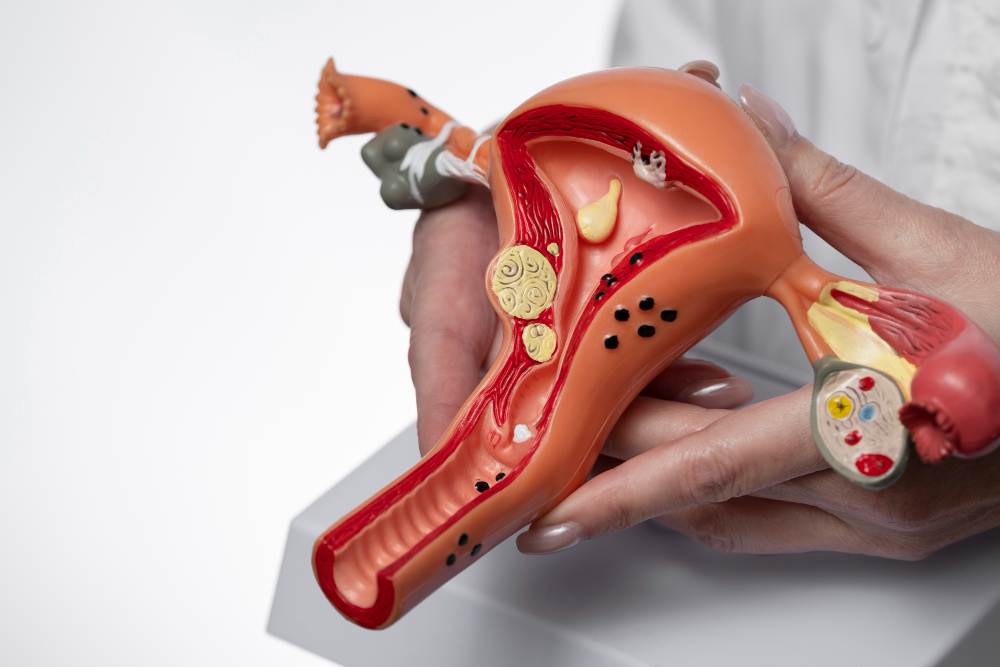Uterine fibroids represent a prevalent form of noncancerous growth that can manifest within or on the uterus. While not all fibroids exhibit symptoms, those that do can lead to issues such as heavy menstrual bleeding, back pain, frequent urination, and discomfort during sexual intercourse.
Although smaller fibroids may necessitate minimal intervention, larger ones might require medication or surgical procedures for management.
Uterine fibroids consist of muscle and tissue growths forming within the uterine wall. They are generally benign in nature and are the most common type of noncancerous tumors found in individuals with a uterus.
Locations and Types
These fibroids can develop either as solitary nodules or in clusters, varying greatly in size, from as small as a millimeter to larger masses exceeding 20 centimeters in diameter.
They can emerge within the uterine wall, within the uterine cavity, or on its outer surface. Different types of fibroids include intramural fibroids (embedded within the uterine wall), submucosal fibroids (growing beneath the inner uterine lining), subserosal fibroids (expanding beneath the outer uterine lining), and pedunculated fibroids (attached to the uterus via a stalk or stem).
Prevalence and Risk Factors
Fibroids are highly prevalent, affecting between 40% to 80% of individuals with a uterus, predominantly within the age range of 30 to 50 years. Risk factors for their development include obesity, familial history of fibroids, early onset of menstruation, and late menopausal age.
Symptoms and Complications
While small fibroids may remain asymptomatic, larger ones can trigger various symptoms, including excessive menstrual bleeding, intermenstrual bleeding, pelvic pressure, urinary frequency, sexual discomfort, and back pain.
Complications arising from fibroids may include severe pain, abdominal swelling, anemia due to excessive bleeding, and, rarely, infertility.
Diagnosis
Diagnosing uterine fibroids typically involves pelvic examinations, with symptoms often guiding further diagnostic tests. These may include ultrasonography, magnetic resonance imaging (MRI), computed tomography (CT) scans, hysteroscopy, sonohysterography, and laparoscopy.
Treatment Options
Treatment approaches for uterine fibroids hinge upon factors such as fibroid size, number, location, and associated symptoms. While observation may suffice for asymptomatic fibroids, symptomatic cases may necessitate intervention.
Medications
For symptom management, various medications are available, including over-the-counter pain relievers, iron supplements to counter anemia, and hormonal contraceptives to regulate bleeding and alleviate menstrual cramps. Gonadotropin-releasing hormone (GnRH) agonists may be prescribed to shrink fibroids temporarily.
Surgical Interventions
Surgical options range from myomectomy, which involves removing fibroids while preserving the uterus, to hysterectomy, which entails complete uterine removal. Minimally invasive procedures such as laparoscopy and robotic-assisted surgeries offer alternatives to traditional open procedures, with uterine fibroid embolization and radiofrequency ablation presenting additional options.
Risks and Considerations
Each treatment modality carries inherent risks, including medication side effects and surgical complications such as infection and bleeding. Furthermore, certain surgical approaches may impact future fertility, necessitating careful consideration of individual circumstances and reproductive goals.
Preventive Measures
While fibroids cannot be entirely prevented, maintaining a healthy weight and undergoing regular pelvic examinations may reduce the risk. Monitoring small fibroids under medical guidance allows for timely intervention if necessary.
Uterine fibroids represent a common gynecological concern with diverse manifestations and treatment options.
Individualized management, considering factors such as symptom severity and fertility preferences, is paramount in ensuring optimal outcomes for affected individuals.



